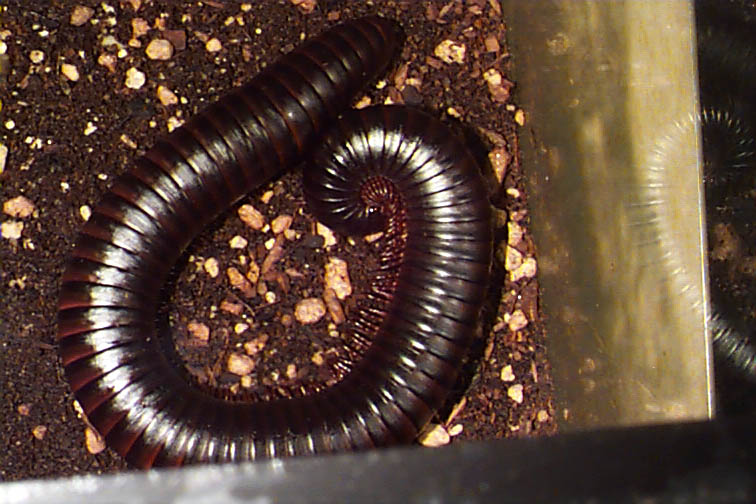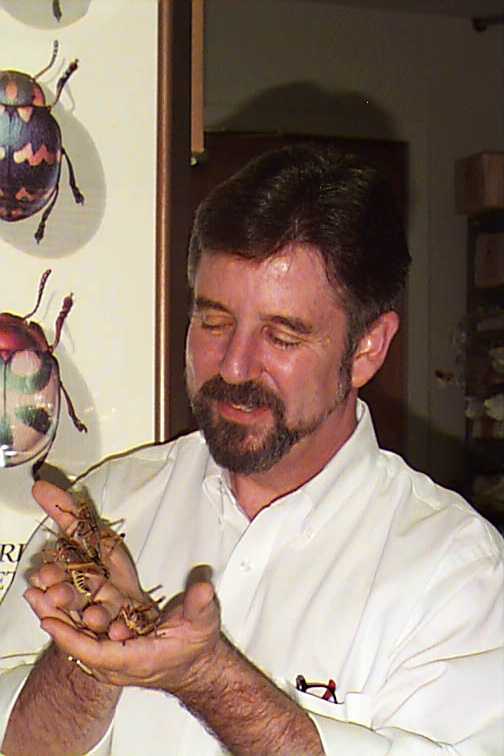
College of Science & Engineering Alumni Newsletter
Spring
2000
Insect Ambassadors
By Merrik Bush-Pirkle

College of Science & Engineering Alumni Newsletter
Spring
2000
Insect Ambassadors
By Merrik Bush-Pirkle
They
creep in Australia, scuttle in Arizona, hide in Malaysia and hiss in Trinidad.
But at the nonprofit Center for Ecosystem Survival (CES), they educate,
delight and inspire.
“They”
are an international troop of insects, which on this particular day include
leaf-shaped walking sticks, vinegar-shooting whip scorpions, giant thorny
leaf bugs and hissing cockroaches. They’re also just a sampling of the
exotic invertebrates inhabiting the Center’s Insect Discovery Lab, an educational
outreach program hosted by San Francisco State University. Under the watchful
eye and lively oratory of CES Director Norman Gershenz, these hands-on
teaching aides make regular visits to Bay Area classrooms, where they help
Gershenz educate children about rainforest biodiversity, conservation and
the sheer wonder of nature.
“Every child is born
a naturalist,” says Gershenz, who carefully extracts what appears to be
a stem of dead, brown leaves from a large terrarium. “They haven’t developed
phobias yet, so this is the time to get them excited about nature. Insects
are great teaching tools with amazing stories to tell, particularly with
regard to their place in an ecosystem.”
As
if on cue, the 5-inch-long wilted stem Gershenz now holds in his hand begins
to move of its own accord. A closer look reveals a pair of tiny black eyes
and two sets of barbed toes where leaf tips might have been. Wearing a
sly smile and a twinkle in his eye at what must be a standard foil practiced
regularly upon unwitting observers, Gershenz explains the well-camouflaged
walking stick’s role in plant regeneration. He carefully returns the unusual
creature to its leafy haven and continues where he left off talking.
“By
connecting these insects to the intricate living network of their surrounding
environment—and even their importance to us, we can make the point that
preserving whole ecosystems—such as rainforests or ocean reefs—is the only
real way to preserve species from extinction.”
The
lab, co-founded last June by local entomologist Leslie Saul, is the latest
outgrowth of the Center’s decade-long effort to protect the world’s last
great centers of biodiversity. Through partnerships with zoos, aquariums,
nature centers, universities and public schools, CES has succeeded in saving
millions of acres of critical rainforest and reef habitat in Central and
South America, Southeast Asia and Micronesia. Fund-raising and outreach
programs include the Conservation Parking Meter, Bowl-the-Planet, the highly
successful Adopt-An-Acre and Adopt-A-Reef campaigns and, more recently,
the Insect Discovery Lab.
The six-month-old program is Gershenz’s latest attempt to inspire children
to take an active interest in conserving endangered habitats. Although
some might balk at asking children to help in such a daunting endeavor,
Gershenz has successfully challenged schools and individual classrooms
across the nation to come up with unique ways to raise money to adopt threatened
habitats throughout the world. Before developing the Insect Discovery Lab,
Gershenz and colleagues had for years appealed to the sensibilities of
youths and teachers through the use of slide shows, lively language, and
engaging science and art projects. He relates some of the more successful
Adopt-An-Acre campaigns students have launched, his pride in their dedication
and achievements clear in his voice.
“One Colorado school raffled off the privilege of tarring and feathering
the principal, who had a great sense of humor about the whole thing,” says
Gershenz. “I think they used chocolate and mustard instead of tar, but
I can’t be sure. All in all, the kids raised about $1,500.”
Any effort makes a difference, he says, adding that k-12 schools in all
50 states have participated in the Adopt-An-Acre program in one way or
another. “At one high school, they simply sold carnations at the prom.
Every bit helps.”
Checking his watch, Gershenz realizes he’s running short on time before
his next presentation. This one, at a day care center in Marin, will garner
him a color photo in the local newspaper, accompanied by a few inches of
text and the Center’s phone number. For the next week, he’ll be barraged
with calls from schools, libraries, parents and even kids asking how they
can get the insects into their classrooms for a show-and-tell session.
As Gershenz fills his compact traveling cases with insect ambassadors from
regions far outside this modest lab, he makes a final point. “How we use
the earth from this point on comes from what we teach here on out.”
-- Merrik Bush-Pirkle

Giant African Millipede
- Kenya, Africa
Whip scorpion from
Arizona, Sonoran desert
|

Norm Gershenz holding some Eastern lubber grasshoppers from the Florida Everglades |